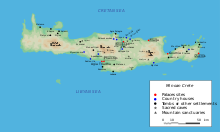Early Minoan III
 |
|
| Period | Bronze Age Europe |
|---|---|
| Dates | c. 2600 BC – c. 1100 BC |
| Major sites | Knossos, Gortyn |
| Preceded by | Cycladic culture |
| Followed by | Mycenaean Greece |
|
Bronze Age |
|---|
| ↑ Chalcolithic |
|
Near East (c. 3300–1200 BC) South Asia (c. 3000–1200 BC) Europe (c. 3200–600 BC)
China (c. 2000–700 BC) |
| ↓Iron Age |
Near East (c. 3300–1200 BC)
South Asia (c. 3000–1200 BC)
Europe (c. 3200–600 BC)
China (c. 2000–700 BC)
arsenical bronze
writing, literature
sword, chariot
The Minoan civilization was an Aegean Bronze Age civilization on the island of Crete and other Aegean islands which flourished from about 2600 to 1100 BC. It preceded the Mycenaean civilization of Ancient Greece. The civilization was rediscovered at the beginning of the 20th century through the work of British archaeologist Arthur Evans. It has been described as the earliest of its kind in Europe, with historian Will Durant calling the Minoans "the first link in the European chain".
The term "Minoan", which refers to the mythical King Minos, originally described the pottery of the period. Minos was associated in Greek mythology with the labyrinth and the Minotaur, which Evans identified with the site at Knossos (the largest Minoan site). According to Homer, Crete once had 90 cities.
...
Wikipedia
